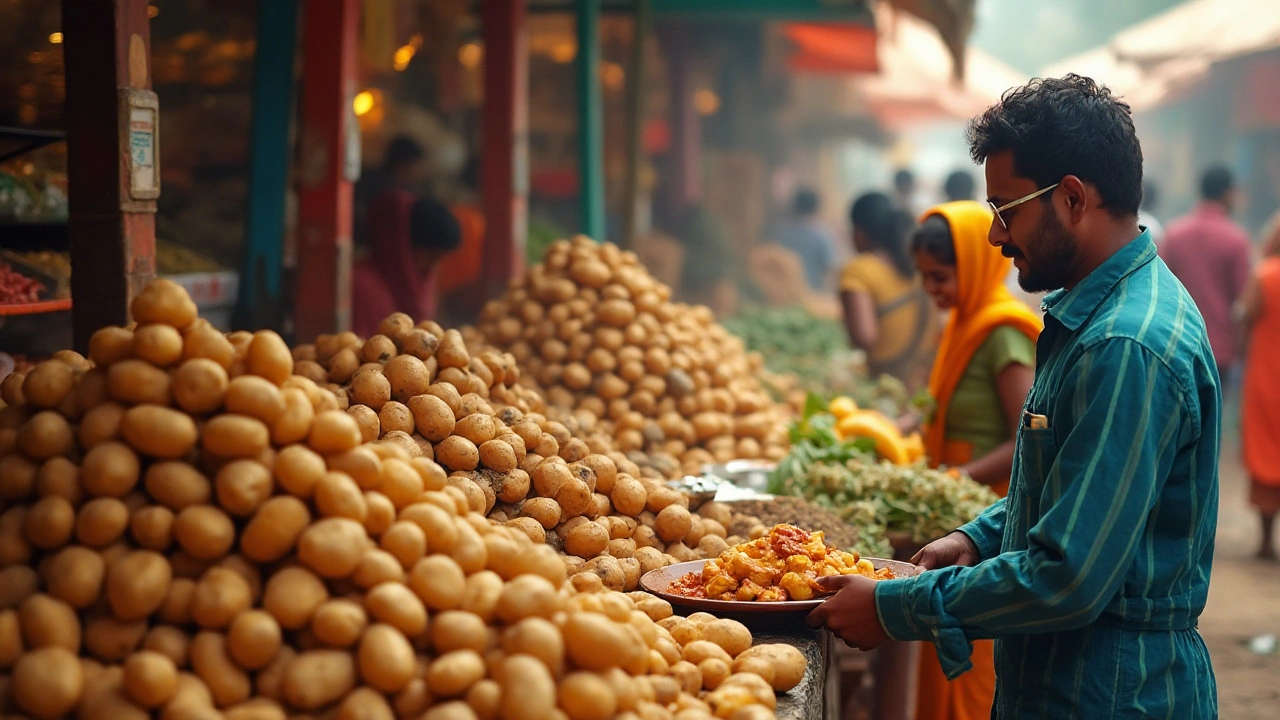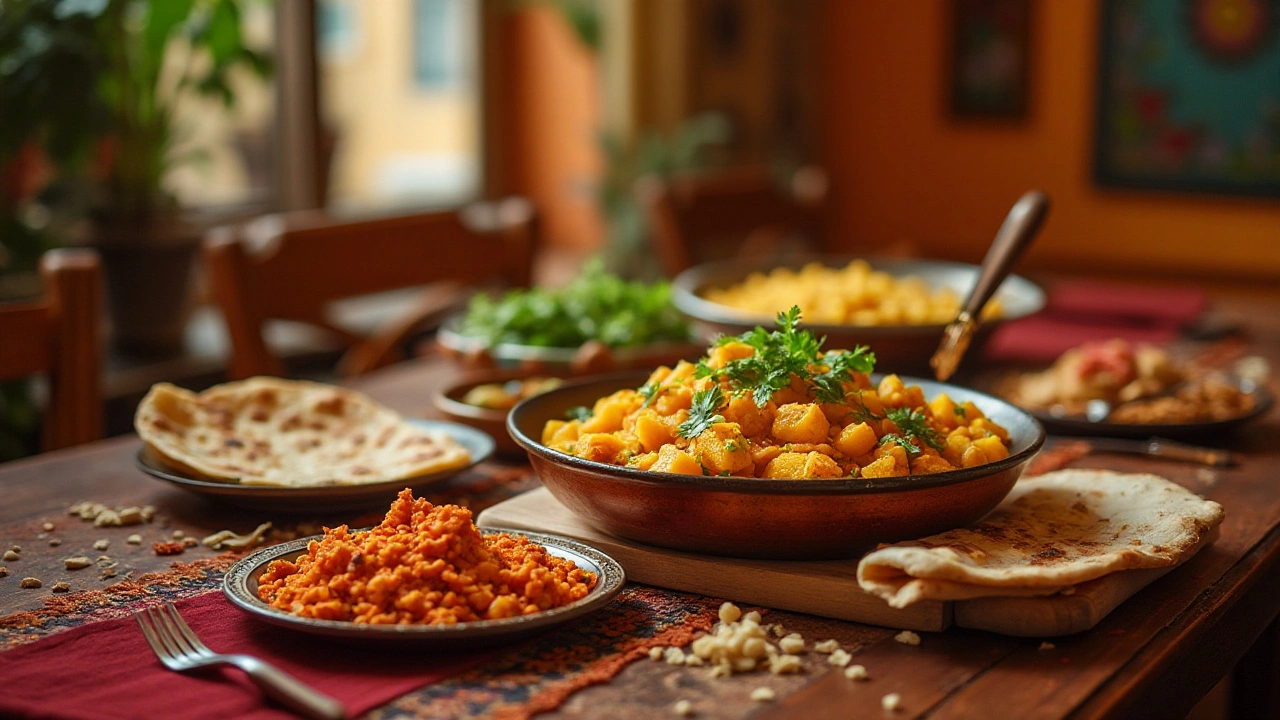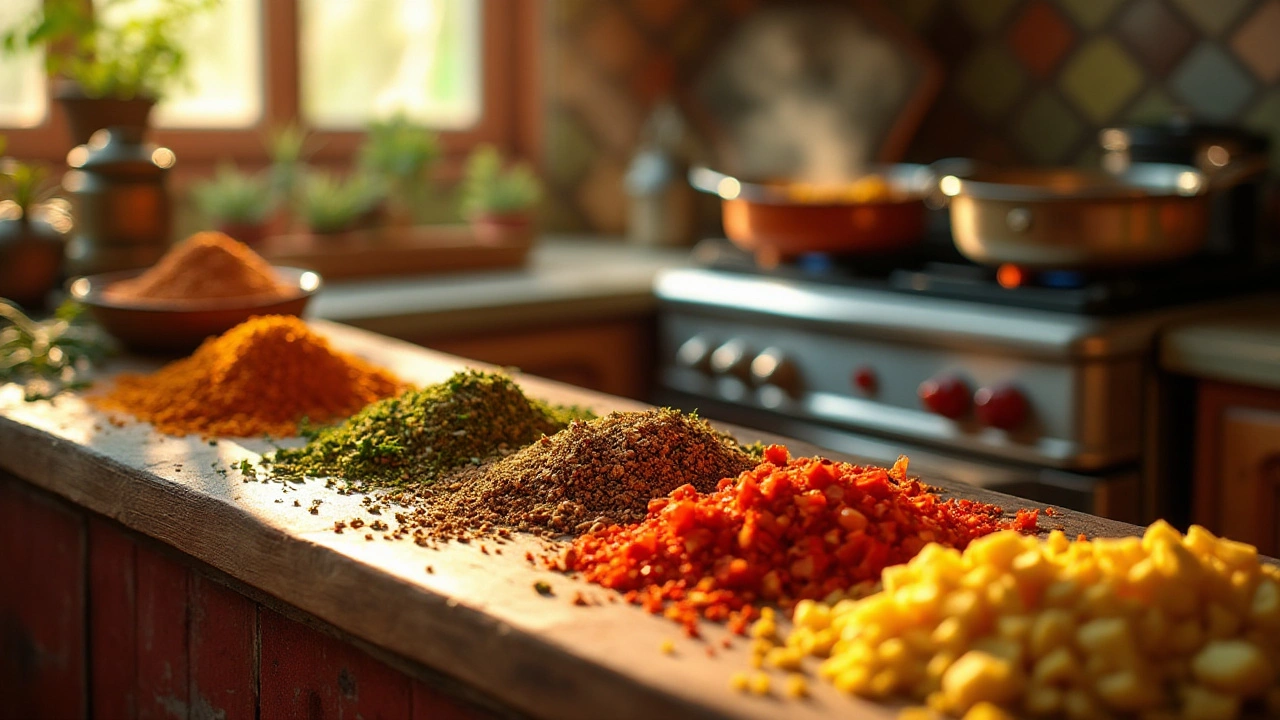Indian cuisine captivates senses with its symphony of spices and ingredients, each dish narrating a story of diverse regions and traditions. Among the cast of culinary characters, the potato stands out, proving its versatility in enhancing the taste and texture of many vegetarian delights. Often considered a mere sidekick in global cuisines, in India, it shares center stage with legacies of lentils and an array of vegetables.
This journey through the world of Indian vegetarian dishes reveals the pivotal roles potatoes play, from traditional curries to reinvented street snacks. In this article, we embark on an exploration of how this unassuming tuber has weaved itself into the fabric of India’s gastronomic tapestry. As you read on, discover the influence, preparation methods, and regional nuances that make potatoes indispensable in crafting the country’s vegetarian flavors.
- Historical Influence of Potatoes in India
- Popular Potato-Based Vegetarian Dishes
- Culinary Techniques and Recipes
- Regional Variations and Potatoes
- Health Benefits of Potatoes in Indian Diet
Historical Influence of Potatoes in India
For many, the image of Indian cuisine conjures fragrant spices, colorful curries, and an array of vegetables. Yet, nestled among these, the potato finds its place as a beloved staple. The story of potatoes in India, however, isn't as ancient as some might think. Introduced to Indian soil by Portuguese traders in the late 16th century, the initial acceptance of the potato was slow. It traversed various regions like a silent observer, subtly finding favor with local tastes and traditions.
As time meandered forward, the potato's potential unfolded through Indian cuisine. During the British colonial era, an era marked by profound culinary exchanges, the tuber emerged as a convenient and nourishing addition. With the rise of agricultural innovations, potatoes were cultivated more widely, leading to their nationwide embrace. India’s agrarian society found the potato compatible with local conditions. Eventually, farmers across the subcontinent adapted it to different climates and terrains, paving the way for its ubiquitous presence in today's kitchens.
It’s intriguing how the potato, not originally a part of Indian gastronomy, came to be integrated so seamlessly. Various Indian dishes, from the iconic aloo gobi to the comforting masala dosa, highlight the potato's versatility and adaptability. The potato often served as a diplomatic ingredient, bridging culinary differences across regions. As noted by food historian K.T. Achaya, ```
" The potato exemplifies how colonial exchanges have long-lasting impacts on local cuisines, adapting foreign ingredients into the heart of cultural identity."``` These influences, intertwined with India’s vast culinary heritage, showcase the subtleties and resilience of the humble potato.
Given its broad acceptance, India's embrace of the potato showcases its magical transformation from foreign to familiar. The versatility of this tuber in vegetarian Indian dishes is evident, whether it's mashed into spicy patties, combined into rich curries, or celebrated in street snacks like samosas. Its adaptability does not merely lie in its flavor, but also in the nutrition it adds. Starch-rich and filling, potatoes offer sustenance that is indispensable in many Indian diets.
Today, India stands impressively second in global potato production, reflecting not only on the farmers’ expertise but also on the crop's immense popularity. Infused deeply into culinary practices, potatoes have leaped past being seen simply as an introduced species, solidifying their role as an enduring ally to Indian vegetarian fare. This quantitative ascent is both testamentary of its acceptance and indicative of its potential in enhancing the Indian gastronomic repertoire.
Popular Potato-Based Vegetarian Dishes
When you traverse the vast landscape of Indian cuisine, you'll quickly realize that the humble potato is a star ingredient in countless vegetarian dishes. One such classic is Aloo Gobi, a beautifully spiced combination of potatoes and cauliflower. The blend of turmeric, cumin, and coriander gives this dish its distinctive golden hue, making it a staple on any Indian dining table. Some households even add peas for extra flavor and texture. Versatile by nature, Aloo Gobi can be either thick or slightly soupy, depending on regional preferences.
Then comes Dum Aloo, a dish that elevates baby potatoes to gourmet status. Originating from the Kashmiri cuisine, the dish is known for its rich and creamy gravy. Baby potatoes are typically fried until golden before being simmered in a mixture of yogurt and spices. The spices are key in achieving the authentic taste—hot and aromatic with cloves, cinnamon, and cardamom imparting that unique Kashmiri fragrance.
In the bustling streets of Mumbai, you’ll often encounter Batata Vada, a popular street food made of spiced potato balls coated in gram flour batter and deep-fried to a crispy finish. Typically, these delights are served with chutneys or as Vada Pav—nestled in a bun, it’s akin to an Indian vegetarian burger. The Batata Vada’s crunch complemented by sautéd green chilies creates a taste that’s hard to forget.
Statistics Table: Potato Consumption in India
| Year | Consumption (Million Tonnes) |
|---|---|
| 2020 | 50.1 |
| 2021 | 52.3 |
| 2022 | 55.4 |
For a simpler everyday meal, there’s Aloo Paratha, a traditional breakfast staple in Northern India. These unleavened flatbreads are stuffed with a mixture of mashed potatoes seasoned with spices and herbs. A dollop of butter on top and some yogurt or pickle on the side make it a comforting and fulfilling meal. No surprise that Potatoes, often regarded as the workhorse of Indian vegetarian cooking, continue to inspire creativity and innovation in kitchens across the country.

Culinary Techniques and Recipes
In the culinary landscape of Indian cuisine, mastering the art of cooking with potatoes unlocks a world of flavors and textures that are nothing short of transformative. Indian cooking techniques elevate this humble tuber into a multifaceted ingredient, capable of absorbing spices and harmonizing with a wide array of vegetables and legumes. The potato's ability to adapt to various cooking methods—be it frying, boiling, roasting, or mashing—makes it an essential component in crafting numerous vegetarian dishes with depth and character.
One of the quintessential techniques is creating a perfect masala base. This involves chopping and sautéing onions, tomatoes, and ginger-garlic paste with a blend of spices such as cumin, turmeric, coriander, and chili powder. The key to infusing the potatoes with these rich flavors lies in allowing the masala to simmer and thicken before introducing the diced potatoes. This technique, often used in popular dishes like Aloo Gobi or Dum Aloo, ensures the potato pieces soak up the spices, resulting in a deeply aromatic and flavorful dish.
Potatoes can be transformed into Aloo Tikki, a popular street food, by mashing them with spices, green chilies, and coriander before frying them into crispy patties. Here, the culinary technique focuses on achieving a golden crust by shallow frying in oil, while maintaining a soft, savory interior. The contrast in textures achieved through this method is a spoonful of crunchy, melty joy. Adding a twist to this traditional delicacy, some regions include mashed peas for an added layer of sweetness and nutrition. To accompany Aloo Tikki, tamarind or mint chutneys provide a zesty counterbalance.
J. Kenji López-Alt, a renowned food columnist, once noted, "It's not just the spices, but how you use them, that defines the vibrancy of Indian dishes." This wisdom resonates deeply when cooking with potatoes, where the timing and sequence of adding ingredients can transform the taste profile of a dish entirely.
Another delightful preparation is the distinct Bombay Sandwich—a tantalizing party of flavors ensconced between toasted bread. This sandwich typically features thin slices of boiled potato seasoned with chat masala and layered with cucumber, tomato, and a vibrant green chutney. Achieving balance is crucial; the layering should not overpower but rather compliment the ensemble of spices and vegetables. The crispness of toasted bread juxtaposes the softness of the potatoes, creating a medley distinctive to this Mumbai street food favorite. This sandwich is also an example of how versatile the presentation of a simple potato can be, adapting to modern culinary styles while retaining traditional essence.
Cooking techniques vary significantly across Indian regions, but one constant remains—the ability of the potato to harmonize with an array of spices and ingredients. Each cooking style brings out a different flavor aspect, inviting experimentation and discovery. In the northern regions, leady, tangy gravies embrace potatoes, while the southern cuisines celebrate them with coconut milk and zesty tamarind. The diversity extends to preparation methods too, whether steamed, curried, or baked, each adapting to the dietary preferences and local tastes. Exploring these culinary techniques opens the door to dynamic flavors that are intrinsically Indian yet universally appealing.
Regional Variations and Potatoes
India’s rich culinary tradition is a stunning mosaic of flavors, techniques, and ingredients, all of which change markedly as you travel from one region to another. Potatoes, while ubiquitous, transform in preparation and role depending on the locale. From North to South, and East to West, each state brings its flair to how this starchy delight embarks on an adventure of taste. In the northern plains of Punjab, the hearty aloo paratha—a stuffed flatbread lined with spiced mashed potatoes—graces breakfast tables ubiquitously. As you savor its buttery layers, you experience the harmonious dance of flavors, with the potato's earthiness blending seamlessly with spices like garam masala, cumin, and coriander. Sipping a cup of Punjabi lassi alongside enhances this blissful fusion, capturing the region’s essence.
Journeying towards the East, Bengal embraces potatoes differently. Here, aloo posto makes an impactful case for simplicity. Cubed potatoes meld with poppy seed paste, green chilies, and nigella seeds, reflecting the region’s love for subtly nuanced dishes that prioritize texture. The renowned Bengali sweet, aloo’r dom, presents the potatoes in a rich gravy tempered with bay leaves, cloves, and ginger, often celebrated during festive luncheons.
Further south in Maharashtra, the mighty batata vada takes the stage. A street food icon, it presents a comforting vision of mashed potatoes, garam masala, curry leaves, dipped in a bright chickpea batter, and deep-fried to golden perfection. Tagging along with chutneys, it offers a flavor explosion few can resist. Marathi culture is also neatly encapsulated in batatyachi bhaaji, a humble potato dish subtly dressed in mustard seeds, turmeric, and peanuts, served alongside the quintessential puri.
Exploring the southern realms introduces us to recipes like potato-loaded masala dosa. This crêpe-like rice pancake, hugged by turmeric-studded potato filling, heralds breakfast ritualistic fervor in states like Karnataka and Tamil Nadu. The region’s love for potatoes also thrives in aloo gassi, a richly spiced coconut curry showcasing the diversity in flavor palettes there.
The diversity doesn’t stop there. Gujarat unveils the potato’s versatility through ringan batata nu shaak, a complex dish blending eggplant with potatoes, garnished traditionally with toasted cumin and a whisper of lemon juice.
According to Madhur Jaffrey, a notable Indian food expert, "Potatoes are a canvas for Indian flavors, and their adaptation into regional cuisines shows just how flexible and beloved they have become through Indian culinary history."While Indian food might conjure visions of blazing spices and vivid curries, the potato unites these dishes cross-geographically, promising a comforting familiarity in each bite. An ingredient that blesses both the economic household and celebratory feasts, it is a testament to how regional variations enhance a culinary repertoire, turning the ubiquitous potato into an extraordinary experience across India.

Health Benefits of Potatoes in Indian Diet
Within the rich landscape of Indian food, the potato plays a pivotal role not just for its culinary versatility but also for its array of nutritional benefits. Potatoes are often misunderstood as mere filler foods, overshadowed by more brightly hued vegetables. However, these tubers are a treasure trove of nutrients, fortifying Indian vegetarian dishes with essential vitamins and minerals. Rich in Vitamin C and B6, they support immune function and cellular health, providing an essential boost that aligns well with India's vegetarian lifestyle. The high potassium content in potatoes also promotes heart health, aiding in the regulation of blood pressure and reducing the risk of stroke, making them an appealing option for heart-conscious dietary habits.
Delving into the fiber content, potatoes contribute significantly to digestive health, which is crucial given that a large segment of the Indian diet relies heavily on pulses and grains that benefit from fiber synergy. Dietary fibers present in potatoes not only promote regularity but also aid in maintaining a healthy gut microbiome. Digestion-friendly dishes like aloo sabzi are not just delicious; they symbiotically support gastrointestinal wellness. Alongside their nutritional profile, potatoes have a low allergenic potential compared to other staple foods, reducing dietary risks in a diverse eating environment. Notably, studies and anecdotal evidence frequently underscore the potato's role as a comfort food that bridges cultural and age divides within India.
Nutritionally, potatoes serve as a canvas carrying the diverse flavors of Indian cuisine without overshadowing other vegetables. When incorporated thoughtfully, they balance the dish, creating harmony with spices such as cumin, turmeric, and mustard seeds. This balanced nature supports energy levels without the excessive caloric burden that other starchy foods may carry. It's interesting to note researchers from the National Institute of Nutrition, India, highlighting, “Potatoes' complex carbohydrates make them an excellent energy source for both young and old alike.”
A renowned nutritionist, Dr. Priya Anant, mentions, "The potato's nutrient density and versatility make it an indispensable part of sustainable vegetarian Indian diets."
Emphasizing these attributes should not overlook their efficacious simplicity. Potatoes, especially when unpeeled, retain high levels of antioxidants. These compounds combat oxidative stress, which is linked to various chronic diseases. When balanced with other green and leafy vegetables common in Indian recipes, potatoes enhance the overall nutritional profile, contributing more to balanced meals than initially meets the eye. As sustainable agriculture practices evolve, the cultivation of potatoes also supports Indian farmers, offering them an accessible, economically viable crop that is resilient to climatic shifts. The growing interest in organic and indigenous varieties of potatoes on the Indian subcontinent is a testament to their continuing dietary and economic importance.
